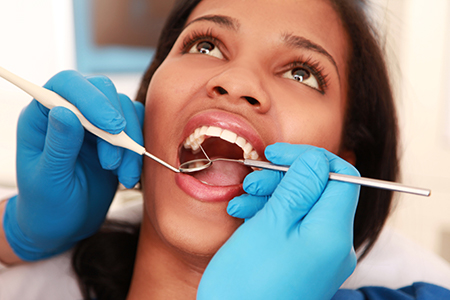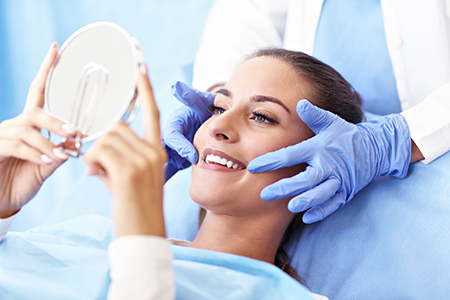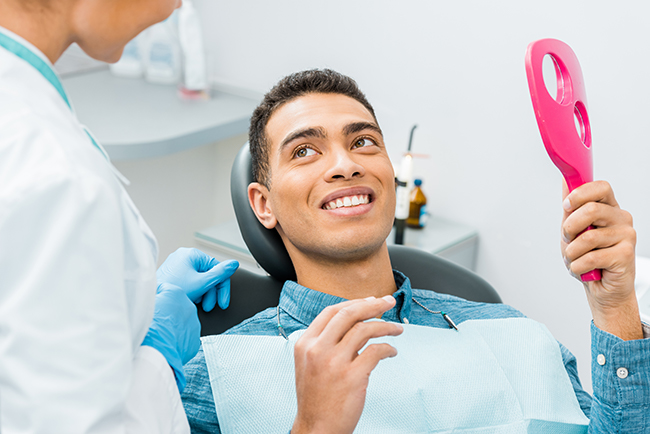At the office of Bahri Dental Group, we emphasize taking a proactive approach as the best way to maintain a healthy, beautiful smile. By coming to our office as recommended for checkup visits and routine dental care, we can help you and every member of your family prevent the onset and progression of many oral health problems. As skilled and experienced providers of dental and orthodontic care, we offer a comprehensive range of preventive services, including examinations, professional teeth cleanings, and oral cancer screenings, along with patient education on hygiene, diet, and healthy practices.
Your first visit to our office establishes your oral health baseline and provides essential information on your dental interests and needs. We begin by carefully reviewing your medical and dental histories and taking special note of all of your dental concerns, as well as any symptoms that you may be experiencing. This initial conversation is followed by a thorough clinical examination, including an oral cancer screening, periodontal evaluation, and an analysis of your occlusion (bite). To perform a comprehensive oral exam, we'll recommend and take diagnostic films as needed. As we take a close look at your smile, we'll examine your teeth, the supporting bone and soft tissues, and the surrounding areas of the mouth, head, and neck. We'll make a note of any signs of clenching or grinding your teeth and assess your TMJ (temporomandibular joint) function. A comprehensive oral exam can also reveal the consequences that certain dietary choices, eating disorders, medications, harmful habits, and inadequate oral hygiene practices may have on your smile.
We want every patient to enjoy the benefits of a healthy and beautiful smile. At the office of Bahri Dental Group, you can rest assured that your oral exam is performed with the utmost care and that every member of our team is sensitive to your needs. Based on your oral exam findings and what we see on your diagnostic films, we'll outline what further treatment, if any, may be needed and discuss all your options in dental and orthodontic care.

At the office of Bahri Dental Group, we recognize that a healthy smile is more than just an attractive asset; it is also essential to one's overall well-being. Harmful conditions affecting your teeth, gums, jaws, and structures in and around the oral cavity can impact your overall well-being. As we perform an oral exam and check for the development of common dental conditions such as tooth decay or gum disease and screen for oral cancer, we also take note of any signs of problematic health issues that may have originated elsewhere in the body.
Today, researchers are establishing more and more links between poor oral health and systemic disease. Mounting evidence supports the idea that dental disease contributes to a range of health issues, including the following conditions:
Digestive disorders
Respiratory Problems
Cardiovascular Disease
Stroke
Diabetes
Alzheimer's Disease
The reverse is also true. Just as oral health problems can be linked to systemic illnesses, diseases in the body can likewise produce oral health issues. According to statistics, more than 90% of all systemic diseases (conditions affecting organs and systems in the body) can manifest signs and symptoms in the oral cavity. Experiencing dry mouth, bad breath, gum problems, ulcerations, or other oral lesions may be indicative of an underlying medical condition.

Enjoying a smile that looks good and functions at its best is not something you can take for granted. To maintain optimal oral health and a vibrant smile requires an effective dental hygiene regimen, a nutritious diet, routine checkups, professional cleanings, and a comprehensive program of preventive care.
Remember, it's important not to hold off seeing the dentist until you're in terrible pain or think there's something wrong. By scheduling a routine appointment for a comprehensive dental checkup and professional cleaning, we can help you keep your smile looking and functioning at its very best.
Our office encourages patients to come in twice a year for routine checkups and professional cleanings. In this way, we can monitor your oral health, reduce your risk of dental disease, and detect any issues early in their onset when they are typically the simplest to treat.
While maintaining a healthy smile depends upon keeping your teeth and gums clean at home, even for the best "brushers" and "flossers," it's difficult to reach every nook and cranny between the teeth and gums. For this reason, we emphasize the importance of professional teeth cleanings. In this way, our hygienist can thoroughly remove any accumulated plaque and tartar from between the teeth and gums, including areas that you may have missed. Since dental plaque harbors the bacteria that are responsible for cavities and gum disease, its removal prevents these disease processes from occurring. Following a dental cleaning and polishing to remove any superficial stains from your teeth, your mouth will feel fresh and clean.
Checkup and cleaning visits also represent an opportunity to educate patients in the best oral hygiene homecare methods and routines to maintain a healthy smile. As your trusted partner in dental and orthodontic care, we'll carefully explain and demonstrate the proper techniques for brushing, flossing, and other healthy oral care practices.
Even though proper dental care is essential at every stage of life, it's especially important for children to establish a strong foundation for a lifetime of oral health. With routine checkups, preventive treatment, and age-appropriate education in the best methods for taking care of their teeth, we can help your little ones protect their smiles from dental disease. We also monitor your children's dental and jaw development as they grow; keeping a close watch to determine if any orthodontic intervention will be needed to align their smiles.
Our goal is to help you and every member of your family establish healthy practices that will last a lifetime. At the office of Bahri Dental Group, we're proud of the reputation we've established for providing skilled and compassionate care. We work hard to make every visit to our office a positive experience while building long-standing relationships with our patients and achieving outstanding treatment outcomes.
Although we perform a thorough visual inspection of every aspect of your smile, the only way to see the deeper structures of the teeth, as well as the surrounding tissues and bone, is with dental x-rays or radiographs. Diagnostic x-rays not only reveal the presence of dental disease, but they also provide valuable information on the development, health, and integrity of teeth and orofacial structures.
Thanks to advances in dental technology, x-rays have entered the digital age. Instead of using traditional film-based methods, which involved long-exposure times and developing solutions, digital x-ray images can now be acquired, stored, and managed via digital sensors and integrated software programs.
Digital radiography offers several benefits to the patient, including the following:
Quicker with minimal exposure to x-ray radiation
Images can be viewed immediately after acquisition
Images can be electronically shared
Digital radiographs do not require any developing chemicals, create less waste, and are safer for the environment
Images are immediately stored in the patient's electronic file, where they can be easily viewed on a screen, shared, or printed out.

The type of diagnostic images our office will recommend depends on the nature of your visit and your oral healthcare needs.
Here's a list of some of the most common diagnostic films and the value of these images:
Periapical x-ray - This small film is typically taken of an individual tooth and provides a view of the entire tooth from the top of the crown to the tip of the root and bone adjacent to it.
Bitewing x-ray - This small film captures detailed views of the crowns of the premolars or molars and is typically used to check for dental decay.
Full Mouth Series - This set of x-rays consists of bitewing and periapical views of all the teeth.
Panoramic Film (panorex) - This film provides a 2D panoramic view of all the teeth and the left and right sides of the jaw. It offers a view of erupted teeth, developing teeth, impacted teeth, and allows an assessment of the health and integrity of the jawbone.
Cephalometric Film - This film provides a profile view of the face and jaws and is often used by orthodontists to assess a patient's skeletal facial and jaw growth.
Today, it's also possible to capture detailed three-dimensional images for diagnostic purposes, treatment planning, and the delivery of dental care. By using Cone-beam computed tomography (CBCT) your dentist can acquire, analyze, and reconstruct 3D images of a patient's teeth, jaws, and surrounding anatomy. This technology is often employed for diagnosis, surgical planning, treatment, and the accurate placement of dental implants.
An oral exam is a comprehensive clinical review of the teeth, gums, oral soft tissues, jaw joints and surrounding structures to assess current health and identify early signs of disease. During an exam a clinician evaluates bite function, checks for wear patterns from clenching or grinding, and looks for abnormalities that may require further investigation. Regular oral exams allow clinicians to detect problems at an early stage when treatment is often simpler and outcomes are better.
Beyond diagnosing cavities and gum disease, oral exams play a preventive role by establishing a baseline for each patient and guiding personalized home care and professional recommendations. They also include screening steps that can identify indicators of systemic illness or oral cancer, which improves the chances of successful intervention. Maintaining a schedule of routine exams supports both long-term oral health and overall well-being.
Your first visit begins with a careful review of your medical and dental history and a discussion of any symptoms or concerns you may have. At the office of Bahri Dental Group the clinical portion includes a thorough visual and tactile examination, an oral cancer screening, a periodontal assessment and an occlusal (bite) analysis. Diagnostic images such as digital x-rays are recommended as needed to view tooth roots, bone and other structures not visible in a standard exam.
After the clinical evaluation, the dentist or hygienist will explain any findings, answer your questions and outline recommended next steps or preventive measures. This conversation includes clear, evidence-based options so you can make an informed decision about care. The visit sets a baseline record that helps the team monitor changes over time and tailor future appointments to your needs.
For most patients, routine oral exams and professional cleanings every six months provide reliable monitoring and preventive care that reduce the risk of dental disease. That interval allows clinicians to remove plaque and tartar from areas that are difficult to clean at home and to catch early signs of cavities, gum disease or other issues. Some patients with active periodontal disease, a history of rapid decay, certain medical conditions or other risk factors may need more frequent visits tailored to their individual risk profile.
Frequency is determined by a combination of clinical findings, personal oral hygiene practices and overall health status, so the dental team will recommend a schedule that best supports your long-term oral health. Consistent follow-up visits also reinforce homecare guidance and allow timely adjustments to preventive strategies. Staying on a recommended schedule optimizes outcomes and helps avoid more complex treatment later on.
Dental x-rays reveal structures that cannot be seen during a visual exam, including the roots of teeth, supporting bone, interproximal decay and the position of unerupted or impacted teeth. These images help clinicians detect decay between teeth, evaluate bone levels for periodontal disease and identify other conditions that may affect treatment planning. X-rays also monitor tooth development and changes over time, which is particularly important for growing children and patients undergoing orthodontic or surgical planning.
Modern digital radiography reduces radiation exposure and allows images to be viewed immediately and stored in electronic records for comparison. Digital images can be enhanced to reveal subtle findings and can be shared with specialists when collaborative care is needed. When indicated, three-dimensional CBCT imaging provides volumetric detail for complex diagnoses and surgical planning while still being used judiciously to limit exposure.
Common intraoral radiographs include bitewing images that show the crowns of posterior teeth to detect interproximal decay and periapical images that reveal the entire tooth from crown to root for assessing root health and surrounding bone. A full-mouth series combines bitewings and periapicals to provide a complete baseline view of all teeth, while a panoramic film offers a broad two-dimensional view of the jaws, developing teeth and overall bone structure. Cephalometric images provide a profile view used primarily in orthodontic assessment to evaluate skeletal relationships and growth patterns.
For specific diagnostic or surgical needs, cone-beam computed tomography (CBCT) can produce three-dimensional images that clarify anatomy for implant placement, impacted tooth management or complex pathology. The type of image recommended depends on clinical findings and the diagnostic question being asked, and clinicians choose the lowest level of imaging that answers that question effectively. Digital techniques also improve patient safety and record keeping while facilitating treatment planning.
An oral cancer screening is an integral part of a comprehensive oral exam that includes a visual inspection and gentle palpation of the lips, tongue, floor and roof of the mouth, cheeks and the tissues of the throat and neck. The clinician looks for persistent sores, red or white patches, lumps, unexplained bleeding or other irregularities that could warrant further evaluation. Risk factors such as tobacco use, heavy alcohol use and certain viral exposures are reviewed because they increase the likelihood of oral malignancy.
When an abnormality is identified, the team documents the finding, may take adjunctive photographs and will recommend follow-up steps which can include monitoring, referral for biopsy or collaboration with an oral surgeon or oral medicine specialist. Early detection significantly improves prognosis, so routine screening is important even when no symptoms are present. Patients are encouraged to report any persistent oral changes between appointments so they can be examined promptly.
A periodontal evaluation measures the health of the gums and supporting structures by assessing pocket depths around teeth, checking for bleeding on probing, evaluating gum recession and reviewing radiographs for bone loss. These measurements help classify the presence and severity of gingivitis or periodontitis and guide decisions about non-surgical or surgical treatment options. The evaluation also identifies risk factors such as uncontrolled diabetes, smoking or certain medications that can influence periodontal health.
Detecting periodontal disease early allows for interventions that can halt or slow progression and preserve teeth and supporting bone. Treatment may include professional scaling and root planing, more frequent maintenance visits, and targeted homecare instructions to control bacterial biofilm. Because periodontal disease can affect systemic health, a coordinated approach with your medical provider may also be recommended when appropriate.
Prepare for an oral exam by bringing a list of current medications, recent medical updates and a summary of any dental concerns or symptoms you want to discuss. It is helpful to arrive having brushed your teeth so the clinician can make a clear assessment, but avoid aggressive mouth rinses that might mask odors or signs of disease. If you have prior dental records or radiographs from another practice, bringing those materials can speed the establishment of an accurate baseline.
If you experience dental anxiety, let the team know in advance so they can explain each step and offer strategies to improve comfort during the visit. For children, bring any records of growth or previous treatments and be prepared to discuss diet, habits and homecare routines that affect oral development. Clear communication about medical conditions and personal preferences helps the clinician tailor the exam and any subsequent care to your needs.
If the clinical findings indicate the need for further treatment, your clinician will review the options, sequence of care and the clinical reasons behind each recommendation so you can make an informed decision. At the office of Bahri Dental Group in Jacksonville the team will outline next steps and coordinate any needed consultations or referrals to specialists. You should use that discussion to ask about expected timelines, the goals of proposed treatments and how those steps support long-term oral health.
After agreeing on a plan, schedule follow-up appointments as recommended and continue diligent homecare to support healing and treatment success. The dental team will monitor progress at subsequent visits and adjust the plan if clinical response indicates that a different approach would be more effective. Maintaining open communication with your provider ensures care stays aligned with your health needs and preferences.
Oral exams can reveal signs that correlate with systemic conditions such as diabetes, cardiovascular disease, respiratory issues and nutritional deficiencies, because many systemic diseases manifest early symptoms in the mouth. Clinicians look for oral signs like unusual lesions, persistent inflammation or changes in salivary flow that may suggest broader health issues. Documenting and communicating these findings allows for timely collaboration with medical providers when further medical evaluation is warranted.
Regular oral exams therefore serve as an important component of preventive health care by enabling early detection, monitoring chronic conditions that affect oral tissues and reinforcing behavior changes that support both oral and overall wellness. Patients who maintain routine dental care often benefit from coordinated recommendations that address risk factors across disciplines. The result is a more holistic approach to maintaining long-term health.
Our goal is to help every patient experience the benefits of good oral health and a beautiful smile. We value the trust you have placed in our office and strive to provide solutions that meet your dental and orthodontic needs and expectations of care.

Phone